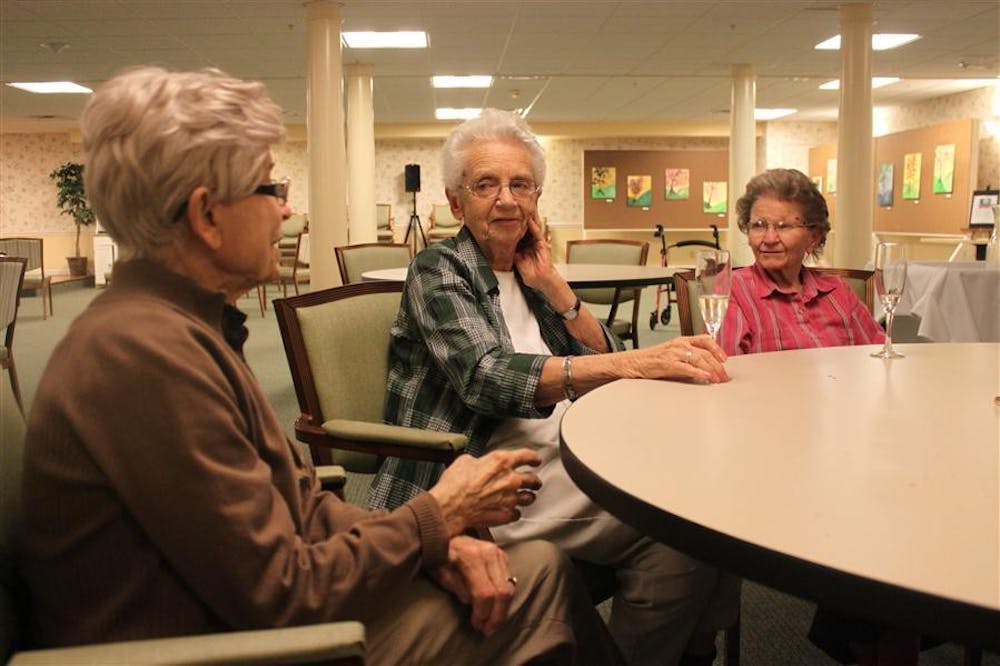As they sat around the table drinking Franzia at social hour, the group of silver-haired women debated: How do you do it? They’ve been voting for up to half a century, but things have changed.
What does it take to vote in Indiana this year?
On the surface, the answer seems simple: a photo identification card.
But for this group of senior residents at the Bell Trace Senior Living Community, and for many other Bloomington citizens, obtaining a proper ID has become a roadblock to voting.
“Does the driver’s license have to be up-to-date?” Barbara Morpurgo asked. “I haven’t used it for a while.”
“I have an ID, but I live at a new address now. Does that count?” Nancy Beaver said.
“Go to the license bureau and get a state ID card,” her friend Marge Brumleve recommended.
“How am I supposed to get there from here?” Beaver said. “I can’t drive.”
These women are far from the only ones talking about voter identification laws.
The subject has been in the national media spotlight for months as states implement, overturn and debate the ethics of asking for an ID at the polls. Although Indiana’s voter ID law has been in place since 2005, it is still causing confusion on the IU campus and in the Bloomington community.
Retirement homes, homeless shelters, disability services groups and nonpartisan advocacy groups have been working to register voters in Monroe Country and make sure they have proper IDs to vote.
“At retirement homes like Bell Trace, everybody knows who everybody is,” said Ann Wrenn, director of the League of Women Voters of Bloomington-Monroe County. “Previously, that was enough to vote with. But things are getting stricter, and the photo ID law is being taken very seriously.”
The LWV is a nonpartisan political organization that encourages informed and active participation in government. The group registered and talked to voters about preparing a proper photo ID at Bell Trace, the Monroe County Public Library and a variety of campus locations.
“It’s very difficult for seniors to understand why, after all those years of voting, they have to prove who they are,” Wrenn said.
Why Indiana has a voter ID law
In 2005, Indiana became the first state to require a voter to produce a government-issued photo ID to vote.
The goal was to reduce voter fraud.
“Indiana’s voter ID law is simply a means of protecting the integrity of our election process so that every vote counts and every voice is heard,” said Pete Seat, director of communications for the Indiana Republican Party.
A plan called the Vote with ID Public Education Initiative was implemented to ensure the public was informed of the new law and that it was implemented equally across the state.
Judith Smith-Ille, Republican chair of the Monroe Country Election Board, helped to educate Monroe County poll workers on the law and their responsibility to uphold it.
“When people go to sign in to vote, the pollsters can look at the person, their photo and address and feel safe that it is the person who is supposed to be voting,” Smith-Ille said.
Similar laws popped up throughout the country, but Indiana’s is one of four voter ID laws categorized as “strict” by the National Conference of State Legislatures. Voters without a photo ID may cast a provisional ballot but must provide a proper ID to their county’s election board within 10 days.
The Indiana photo ID law received a wave of backlash from civil rights groups in and out of the state. The groups argued the new law was an attempt to limit voting for marginalized groups who are less likely to have IDs.
Studies have proven that African American, low-income and older citizens are included in that category.
“Voting is not a privilege, it’s a right,” IU Political Science Professor Marjorie Hershey said. “It’s not a right to make some people work a lot harder in order to have to vote than it is others.”
But in 2008, both the Indiana Supreme Court and the United States Supreme Court ruled the Indiana voter ID is constitutional.
“Because Indiana’s cards are free, the inconvenience of going to the Bureau of Motor
Vehicles, gathering required documents and posing for a photograph does not qualify as a substantial burden on most voters’ right to vote or represent a significant increase over the usual burdens of voting,” Justice John Paul Stevens wrote in the decision.
The voter ID law has been implemented in every election since 2006.
Why voter ID is still a controversy
Voter ID laws (photo and non-photo) have been enacted in some form in 30 states, but resistance to the laws continuously grows stronger.
Opponents argue that voter fraud by voter impersonation, which these laws aim to combat, is not an issue.
According to a database of election fraud compiled by the news organization News21, .5 percent of all 2,068 cases of alleged election fraud since 2000 have been through voter impersonation.
Of the 62 cases of alleged voter fraud in Indiana during that time, zero were cases of voter impersonation. Of the allegations, 58.1 percent were against absentee ballot fraud. Voting absentee does not require a photo ID in Indiana.
Courts are saying the explanations that voter impersonation fraud is too well-concealed to be detected or that it could grow in the future are not sufficient.
Texas’ attempt to enact a strict voter ID law like Indiana’s was blocked by the U.S. District Court in Washington in August. In Pennsylvania, a state judge blocked another strict photo ID law. Polling officials there are now allowed to request identification but can not require it.
Courts in Florida, Ohio, Arizona, Wisconsin and Tennessee have also blocked or postponed voter ID laws until after the 2012 general election.
What you need to vote in Ind.

Get stories like this in your inbox
Subscribe





